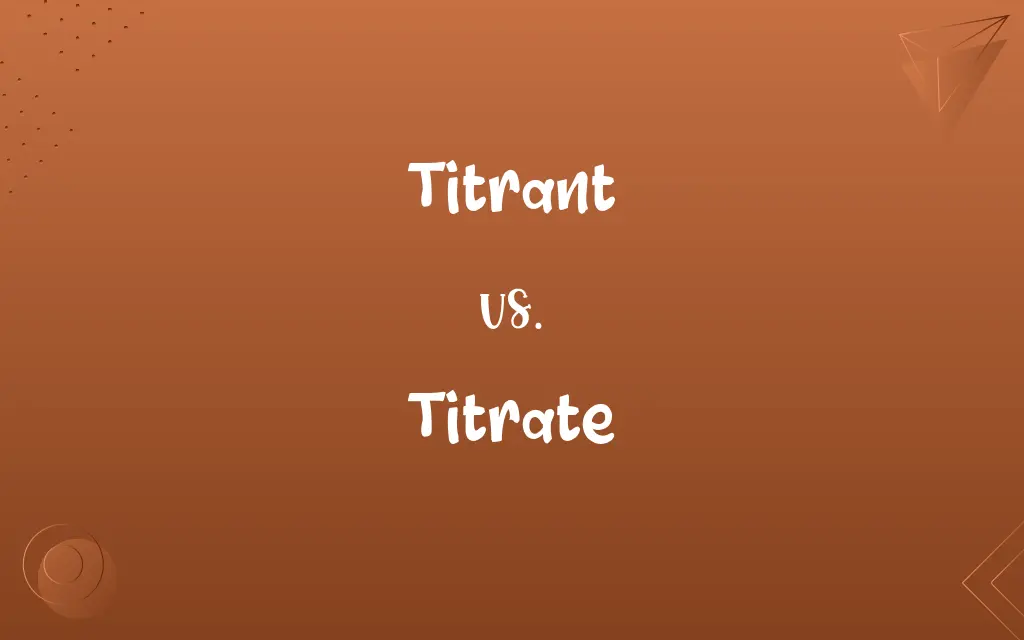Titrant vs. Titrate: Know the Difference

By Shumaila Saeed || Updated on December 25, 2023
A titrant is the solution used in titration to react with a sample, while to titrate is the process of adding the titrant to determine the concentration of a substance.

Key Differences
"Titrant" refers to the solution with a known concentration used in the process of titration. In contrast, "titrate" is a verb describing the act of adding the titrant to a sample in a controlled manner to determine its concentration.
Shumaila Saeed
Dec 07, 2023
A titrant is specifically prepared and standardized for use in titration procedures. To titrate involves gradually adding the titrant to the analyte (the substance being analyzed) until a reaction endpoint is reached.
Shumaila Saeed
Dec 07, 2023
The choice of titrant is crucial for accurate titration results, as it must react predictably with the analyte. When performing titration, the technique of adding the titrant, such as drop by drop, is key to reaching a precise endpoint.
Shumaila Saeed
Dec 07, 2023
Titrants can vary in nature, including acids, bases, or other chemicals, depending on the type of titration. The process of titrating requires careful measurement and observation to determine the endpoint, often indicated by a color change.
Shumaila Saeed
Dec 07, 2023
Comparison Chart
ADVERTISEMENT
Function
To react with the analyte
To determine the concentration of analyte
Shumaila Saeed
Dec 07, 2023
Preparation
Must be prepared and standardized
Involves adding the titrant to the analyte
Shumaila Saeed
Dec 07, 2023
Usage
Used as a reagent in titration
Describes the act of performing titration
Shumaila Saeed
Dec 07, 2023
Importance in Titration
Its concentration and reactivity are crucial
Technique and accuracy are key
Shumaila Saeed
Dec 07, 2023
Titrant and Titrate Definitions
Titrant
Titrant's nature depends on the type of analyte.
For this titration, a strong acid was chosen as the titrant.
Shumaila Saeed
Nov 27, 2023
ADVERTISEMENT
Titrate
It's the process of measuring substance concentration.
They titrate the sample to find the exact concentration of the unknown solution.
Shumaila Saeed
Nov 27, 2023
Titrant
Titrant is a solution of known concentration used in titration.
The chemist used sodium hydroxide as the titrant in the acid-base titration.
Shumaila Saeed
Nov 27, 2023
Titrate
Titrate is to gradually add a titrant to an analyte in titration.
The technician will titrate the solution to determine its acidity.
Shumaila Saeed
Nov 27, 2023
Titrant
Must be accurately measured for successful titration.
The volume of the titrant was carefully recorded during the experiment.
Shumaila Saeed
Nov 27, 2023
Titrate
Titrate involves careful addition of titrant to reach an endpoint.
To titrate accurately, add the titrant drop by drop.
Shumaila Saeed
Nov 27, 2023
ADVERTISEMENT
Titrant
It's the reacting solution in a titration experiment.
A standard titrant is essential for accurate titration results.
Shumaila Saeed
Nov 27, 2023
Titrate
Titrate is an essential technique in quantitative analysis.
In her research, she had to titrate several samples for precise data.
Shumaila Saeed
Nov 27, 2023
Titrant
Titrant interacts with the analyte to reach an endpoint.
The titrant caused a color change, indicating the endpoint.
Shumaila Saeed
Nov 27, 2023
Titrate
Used to determine chemical properties in a lab.
We titrate to assess the purity of chemicals.
Shumaila Saeed
Nov 27, 2023
Titrant
A substance, such as a solution, of known concentration used in titration.
Shumaila Saeed
Oct 19, 2023
Titrate
To determine the concentration of (a solution) by titration or perform the operation of titration.
Shumaila Saeed
Oct 19, 2023
Titrant
(analytical chemistry) The reagent of known concentration and volume used in titrations.
Shumaila Saeed
Oct 19, 2023
Titrate
(analytical chemistry) To ascertain the amount of a constituent in a solution (or other mixture) by measuring the volume of a known concentration (the "standard solution") needed to complete a reaction.
Shumaila Saeed
Oct 19, 2023
Titrate
To adjust the amount of a drug consumed until the desired effects are achieved.
Shumaila Saeed
Oct 19, 2023
Titrate
To analyse, or determine the strength of, by means of standard solutions. Cf. Standardized solution, under Solution.
Shumaila Saeed
Oct 19, 2023
Repeatedly Asked Queries
Can any solution be a titrant?
It must be appropriate for the specific titration type.
Shumaila Saeed
Dec 07, 2023
Why is titration important?
For accurate measurement of substance concentration.
Shumaila Saeed
Dec 07, 2023
Is titrant always a liquid?
Typically, but solid titrants are used in some methods.
Shumaila Saeed
Dec 07, 2023
How do you choose a titrant?
Based on the analyte and the type of reaction needed.
Shumaila Saeed
Dec 07, 2023
What does it mean to titrate?
To add a titrant to an analyte to measure concentration.
Shumaila Saeed
Dec 07, 2023
What's an indicator in titration?
A substance that shows the endpoint, often by color change.
Shumaila Saeed
Dec 07, 2023
How do you know when to stop adding titrant?
When the indicator shows the endpoint.
Shumaila Saeed
Dec 07, 2023
Do you need a lot of titrant to titrate?
The amount varies based on the analyte's concentration.
Shumaila Saeed
Dec 07, 2023
What types of titration are there?
Acid-base, redox, and complexometric, among others.
Shumaila Saeed
Dec 07, 2023
What is volumetric titration?
A method where the volume of titrant added is measured.
Shumaila Saeed
Dec 07, 2023
Is titrate a laboratory-only term?
Mostly, but it's used in other precise measurement contexts.
Shumaila Saeed
Dec 07, 2023
Can you titrate with a weak titrant?
Yes, but it requires careful selection and handling.
Shumaila Saeed
Dec 07, 2023
Can titration errors occur?
Yes, due to measurement inaccuracies or endpoint misjudgment.
Shumaila Saeed
Dec 07, 2023
Share this page
Link for your blog / website
HTML
Link to share via messenger
About Author
Written by
Shumaila SaeedShumaila Saeed, an expert content creator with 6 years of experience, specializes in distilling complex topics into easily digestible comparisons, shining a light on the nuances that both inform and educate readers with clarity and accuracy.






































































